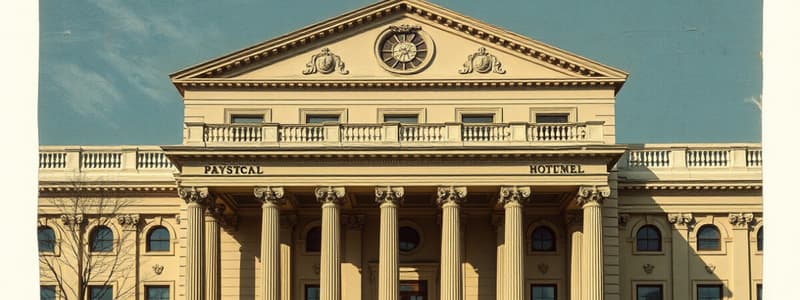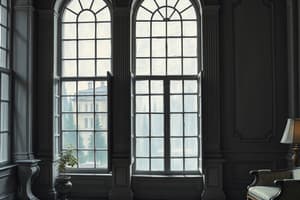Podcast
Questions and Answers
What is Monticello?
What is Monticello?
- A museum in Virginia
- Thomas Jefferson's self-designed home (correct)
- A famous painting
- A famous park in the U.S.
Who designed Monticello?
Who designed Monticello?
Thomas Jefferson
What is 'The Tête à Tête'?
What is 'The Tête à Tête'?
- A sculpture
- A book
- A historical event
- A painting from 'Marriage à la Mode' (correct)
William Hogarth was the first Western artist to work in series.
William Hogarth was the first Western artist to work in series.
Who is depicted in the 'Portrait of Sor Juana Inés de la Cruz'?
Who is depicted in the 'Portrait of Sor Juana Inés de la Cruz'?
What does the orrery represent in 'A Philosopher Giving a Lecture on the Orrery'?
What does the orrery represent in 'A Philosopher Giving a Lecture on the Orrery'?
What style is used in 'A Philosopher Giving a Lecture on the Orrery'?
What style is used in 'A Philosopher Giving a Lecture on the Orrery'?
The painted scene of 'The Tête à Tête' includes dogs chained together, symbolizing the _____ relationship.
The painted scene of 'The Tête à Tête' includes dogs chained together, symbolizing the _____ relationship.
Sor Juana Inés de la Cruz chose to marry to pursue her interests.
Sor Juana Inés de la Cruz chose to marry to pursue her interests.
What does Cabrera's portrait of Sor Juana highlight?
What does Cabrera's portrait of Sor Juana highlight?
Match the following terms with their descriptions:
Match the following terms with their descriptions:
Flashcards are hidden until you start studying
Study Notes
Monticello
- Thomas Jefferson's self-designed home in Virginia (1768-1809 C.E.) and a model of American architecture.
- Influenced by French Neoclassical architecture, preferring it over British styles.
- Design utilizes Palladian style with symmetry, a single story, and Doric order features.
- Constructed with local brick, featuring a 2-column deep portico and a triangular pediment.
- Symbolizes Jefferson's belief that art and architecture could drive social change.
The Tête à Tête
- Created by William Hogarth around 1743 C.E.; a pre-neoclassical oil painting part of Marriage à la Mode series.
- First artist to work in series, portraying a thematic narrative across multiple works.
- Depicts a marriage of convenience with no genuine connection between the couple.
- Contains symbolic elements: chained dogs representing the couple's relationship, and an open music book implying potential infidelity.
- Critiques social norms with visual metaphors, including a statue of Cupid without a nose, indicating a broken marriage.
Portrait of Sor Juana Inés de la Cruz
- Painted by Miguel Cabrera around 1750 C.E., this oil on canvas is a posthumous portrait.
- Sor Juana is recognized as one of the first feminists in the Americas; she lived as a nun in 17th-century Mexico.
- Chose religious life over marriage to pursue intellectual interests, corresponded with notable scholars.
- Cabrera’s portrayal emphasizes her status as an intellectual, featuring her at a desk with books and writing tools.
- Her direct and assertive gaze, along with her nun's badge, reinforces her prominence in literature and thought.
A Philosopher Giving a Lecture on the Orrery
- Created by Joseph Wright of Derby between 1763-1765 C.E., employing tenebrism and chiaroscuro techniques.
- Depicts a philosopher instructing an audience about the solar system model (orrery), symbolizing the transition from religious to scientific views.
- Strong internal light source (gas lamp) serves both as illumination and a metaphor for enlightenment.
- Represents educational accessibility, highlighted by the inclusion of young women learning alongside men.
- Illustrates the rise of philosophical groups and scientific inquiry during the Enlightenment era.
Studying That Suits You
Use AI to generate personalized quizzes and flashcards to suit your learning preferences.





